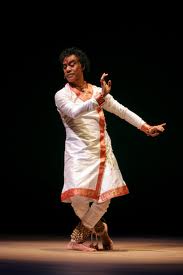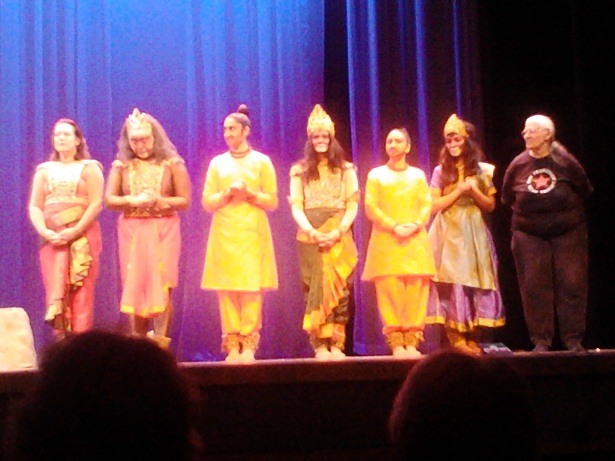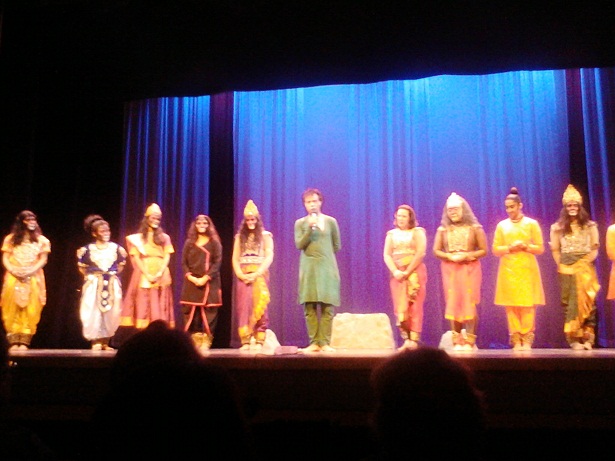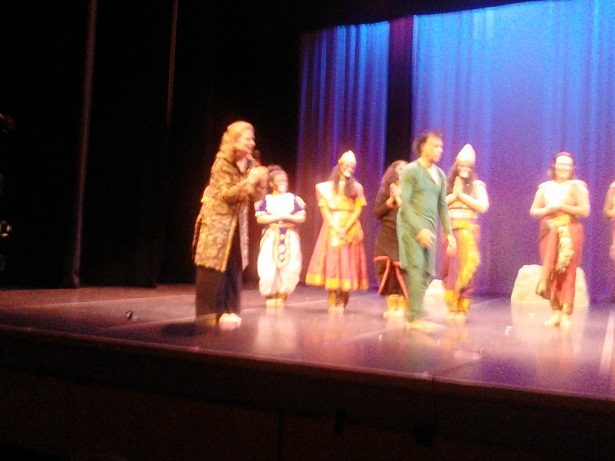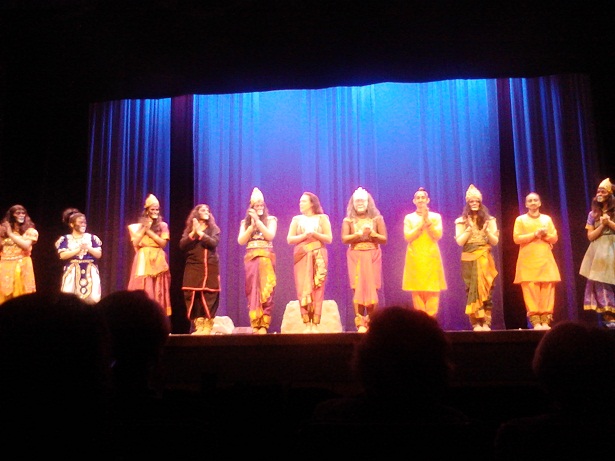Pandit Chitresh Das has been instrumental in bringing Kathak to the US and is credited with firmly establishing Kathak amongst American dancers and the Indian diaspora. In 1979, Das established the Chhandam School of Kathak and the Chitresh Das Dance Company in California. In 2002, he founded Chhandam Nritya Bharati in India. Today, with over ten branches of Chhandam worldwide, Das continues to teach dance as a way of life, a path for attaining self-knowledge and as a service to society. Guruji, as he is affectionately referred to by his students has explored many dimensions of Kathak and has created Kathak Yoga.
He was visiting Boston to present his creation “Sita Haran†a delightful Kathak dance theater that blended the traditional classical art form of Kathak with the advanced theatrical techniques of projection and lighting to create a magnificent presentation that told the tale of the abduction of Sita.
As I approach Panditji, I try to touch his feet and pat comes the response “No no do not touch my feet. Touch your own.. it is good exerciseâ€. I learned that he feels very strongly that women need to be very secure in who they are. “Respect yourself first before offering respect to othersâ€
What motivated him to leave India and come to the US to teach Kathak to a relatively unfamiliar audience? “I was very motivated by so many like Ravi Shankar, Ali Akbar Khan and others who made the journey to the west to bring their art. I think Swami Vivekanada initiated this trend of sharing knowledge in the west. While I cannot compare myself to those great people, my motivation was the same. My mother strongly encouraged me saying – to know your country get out of the countryâ€
For him Kathak is a wonderful way to help society. He emphasizes the need to go to back to our roots and learn Vedanta. “We need to relearn Vedanta and understand what it means to us in a age where our lives are very different from the times those gems were created†says Das.
What does classical dance teach? “Meaning of OM, concept of Ardhanareeswara, Navarasa, Tal, Tayyari (preparedness) Laykari (rhythm) Khusoorti(beauty) Nazakat (grace) are learned when you learn Indian classical dance. I strongly suggest mothers to encourage their sons to learn classical dance for then they will understand the concept of Ardhanaree and really learn to respect women. This can have a transformational effect on country as a wholeâ€
Why did he choose the Ramayana as an epic to present? “ I am so amazed by this epic. I am amazed with the culture and the upbringing that Ram must have had to be able to go to the forest renouncing his rights to the throne without a second thought. What an evolved civilization that must have been for him to be able to do so! So many of the characters lived so close to nature. I wonder what it would have been to fight in the Indian heat. What made them such great souls†asks Pandit ji.
Over the years, his school has transformed from training predominately white American students to training Indian Americans. “People may see it as a change but as you well know Indian Americans are also Americans. I call them ABCD – American Born Confident Desis. The principals of Chhandam are the same and have not changed with time. Sadvyavahar aur Tehzeeb, Prashikshan, Riyaz mehnath ke sath, Sarvagyan, Upaj, Shikhsha, Prachar Aur Surakshakarna, Tyaag aur Seva, Sadhana, Guru-Shishya Parampara are the nine principles of Chhandamâ€
What training does one need to make a career in classical dance? “One needs to have a good understanding of music and choreography. If you are committed and work hard you can make dance a careerâ€
Being in his presence, one forgets he is a 68-year-old man. “Please pray that I can dance for at least 10 more years “ he says humbly. It was an amazing experience to be in the presence of such a great soul!
Any message for the community? "Invest in keeping the classical arts alive. It is the best way to keep the connections with our Indian roots"
Review of Sita Haran
The complex Ramayana tale has sparked the imagination of all artists from the beginning of time. Pandit Chitresh Das’s presentation of a portion of the epic on May 11 at the Sorenson Theater in Babson College was his interpretation of portions on this tale. Creative use of screen projection, exceptional makeup and fabulous music made this a presentation to remember.
The program opened with a “Rang-Manch†presentation by the students of Chhandika School of Dance. Chhandika is run by Gretchen Hayden, a senior disciple of Pandit Chitresh Das.
It was very appropriate that “Ramayana†that literally means the “Journey of Rama†open with a map of India and traced the path of Rama to Chitrakoota which was the setting for the opening act of “Sita Haranâ€. Twelve seasoned dancers of Chhandam performed several scenes from the epic. Pandit Das’s love of Kathakali was fairly visible as he presented and established each character before moving on to the presentation of the episode. The establishment of Ravana as the great devotee of Shiva was a fabulous scene as was his transformation into a rather violent person goaded by his desire to get Sita.
The character of Jatayu shone bright at the last moment as he breathed his last bringing on spams caused by his loss of his wings. As is to be expected in any Ramayana presentation, Hanuman was absolutely brilliant. His makeup and movements were very authentic. The brilliance of theatrics was noticed when Hanuman was able to blend into the backdrop and give us a sense of how he hid himself while eyeing Rama and Lakshmana.
Technically the presentation was perfect. Watching old clips of Sita Haran where Das himself had donned the role of Ravana, one could see how sincerely his students have presented his idea of the various roles.
It is not often one gets to see quality Kathak and it sure was a pleasure to see that at Babason college.
